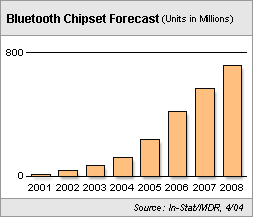Report: Handheld, automotive apps to fuel rapid Bluetooth growth
May 4, 2004 — by LinuxDevices Staff — from the LinuxDevices Archive — viewsAlthough Bluetooth-enabled devices haven't quite entered the true mainstream yet, they are poised to take that next step, according to research finding from market anaylst firm In-Stat/MDR. With Mobile phones, PDAs, and headsets making significant strides over the last year, the automotive market beginning to make an impact, and PMG (Personal Mobile Gateway) products expected to emerge, shipments of… Bluetooth-enabled manufactured equipment will experience a 60 percent CAGR (compound annual growth rate) between 2003 and 2008.
 “Most of the end-use markets for this technology seem to be making significant headway,” says Joyce Putscher, Director of the high-tech market research firm's Converging Markets and Technologies Group. HandsFree regulations and auto manufacturers are helping to drive the movement toward the safety and convenience of cordless headsets, and consumers will be able to use them with a multitude of products, from mobile phones to telematics systems, digital audio players and game devices, PCs, office phones, and emerging stereo systems and wireless speakers. In addition, Putscher believes that “Since CDMA is a large factor in the US, getting embedded Bluetooth-enabled mobile phones into that market is integral for Bluetooth growth in the US.” Bluetooth-enabled CDMA phones are beginning to emerge onto the market, with Sprint PCS carrying a Sony Ericsson CDMA/AMPS Bluetooth-enabled phone.
“Most of the end-use markets for this technology seem to be making significant headway,” says Joyce Putscher, Director of the high-tech market research firm's Converging Markets and Technologies Group. HandsFree regulations and auto manufacturers are helping to drive the movement toward the safety and convenience of cordless headsets, and consumers will be able to use them with a multitude of products, from mobile phones to telematics systems, digital audio players and game devices, PCs, office phones, and emerging stereo systems and wireless speakers. In addition, Putscher believes that “Since CDMA is a large factor in the US, getting embedded Bluetooth-enabled mobile phones into that market is integral for Bluetooth growth in the US.” Bluetooth-enabled CDMA phones are beginning to emerge onto the market, with Sprint PCS carrying a Sony Ericsson CDMA/AMPS Bluetooth-enabled phone.
The automotive market is also beginning to make an impact on Bluetooth demand, from a technology awareness aspect, in addition to the functionality benefits of HandsFree operation. The automotive market will provide a driver for many handsets, headsets, embedded auto solutions, and aftermarket car kits. In addition, demand for PMG products, and their associated capabilities and services, will provide another driver for Bluetooth-enabled products. A number of wireless operators see PMGs as an opportunity to increase their Average Revenue Per Unit (ARPU) and to offer service differentiation. However, the successful emergence of PMGs will depend on the willingness of operators to embrace this new breed of devices. PMG handsets and companion devices, such as cameras and messaging devices, will jump start deployments.
In-Stat/MDR has also found that:
- Products that are compliant with the Bluetooth 1.2 version that includes the Adaptive Frequency Hopping (AFH) profile will emerge this year. Not only for notebooks, this coexistence profile is desirable for headsets, and other applications as well.
- In 2008, manufactured Bluetooth-enabled equipment will still be led by mobile phones.
- The Bluetooth semiconductor market made concrete progress last year, with final 2003 worldwide chipset shipments just about doubling, from those in 2002, to 69 million units.
- Unlike Ultra-Wideband or 802.15.4, Bluetooth supports voice. That is one of the reasons In-Stat/MDR does not consider these technologies as major competition for Bluetooth in the near future.
The report, Bluetooth 2004: Poised for the Mainstream (#IN0401211MI), provides forecasts for manufactured Bluetooth-enabled equipment and semiconductor shipments by detailed application. The forecast for radio, baseband, and host-supported silicon solutions is presented, as well as semiconductor shipments by HCI breakout, geographic region shipments and design wins, shipments by Class 1 vs. Class 2/3, and application segmentations for Class 1. Years 2001-2008 are provided. This year, In-Stat/MDR's Personal Mobile Gateway forecast has been added. The report price is $3,495 USD.
Copyright © 2004 In-Stat/MDR. Reproduced with permission by LinuxDevices.com
This article was originally published on LinuxDevices.com and has been donated to the open source community by QuinStreet Inc. Please visit LinuxToday.com for up-to-date news and articles about Linux and open source.